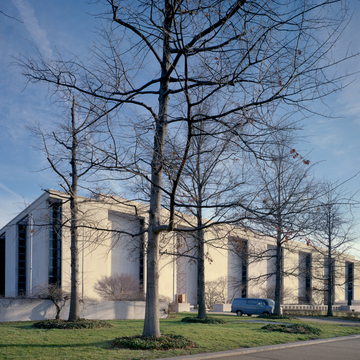You are here
National Museum of American History
Congressional approval in 1955 for the Museum of History and Technology and its site on the north side of the Mall next to the Natural History Museum was accompanied by a $36 million appropriation. Secretary of the Smithsonian Leonard Carmichael's attitude was at once conservative and innovative. He wished the new museum to fit into the “prevailing architecture” of Washington, yet he wanted the interior to function as a model of architectural futurism to match up-to-date exhibit methods and contents that demonstrated American superiority in science and technology. That is, the museum was to be built from the inside out, with the exterior form unrelated to its innovative interiors. The once-great firm of McKim, Mead and White, founded in 1879, was selected to design the building in 1956. Its architects had continued to design in a conservative tradition well into the modern era, attempting to fuse principles
James Kellum Smith was responsible for the initial design of the modernized Beaux-Arts shell of the museum. At his death he was replaced by Walker O. Cain of the successor firm of Steinman, Cain and White. The building's broad terrace seen from the Mall serves as the roof of a full-story level set against the embankment fronting on Constitution Avenue. Its compact rectangular mass culminates in a recessed attic story, a typical Beaux-Arts solution to diminish the height of large buildings. All four facades were composed in a uniform manner; in fact the museum was conceived as a modern rendition of a peripteral temple on the model of the Lincoln Memorial. Regularly spaced, rectangular slabs of wall set vertically that rise from the podium to the cornice line are treated as a modern equivalent of columns. They are held away from the inner wall by vertical windows of solar gray glass, creating the alternation of light and shade associated with columnar architecture. At the Mall entrance, these slabs provide a surface for inscriptions relating to American history and invention, another instance of Beaux-Arts influence.
Although the design itself is a bland attempt to modernize traditional architecture, many of the structural aspects were innovative at the time. The remarkably thin (16 3/8 inches) walls consist of a sandwich composed of structural precast concrete panels, rigid insulation, and a facing of pink Tennessee marble sandblasted to give a uniform surface. The structural joints used to hang these panels, so that they appear as freestanding units floating on the surface, were devised for this building. The interior plan was adapted from designs proposed in 1946 by Frank Taylor for a modern museum of science, engineering, and industry. In Taylor's plan a central rotunda flanked by two square storage rooms provided a core surrounded by a continuous unbroken gallery where exhibits might merge with one another in a continuum of history and technology or be subdivided by movable walls. This flexibility of space was allied to new concepts of museology by which visitors were encouraged to participate in the exhibits, even to handle objects. Although these planning and display concepts responded to the reality of huge numbers of visitors occupying the museum at the same time, the lack of clear architectural order and hierarchy have resulted in incoherent interiors, where visitors are disoriented and regularly have to be directed to exits, as the architecture does not provide the necessary clues. Signs are so numerous (and intrusive) as to become a meaningless jumble. Such an internalized experience, where natural light and a view to
Writing Credits
If SAH Archipedia has been useful to you, please consider supporting it.
SAH Archipedia tells the story of the United States through its buildings, landscapes, and cities. This freely available resource empowers the public with authoritative knowledge that deepens their understanding and appreciation of the built environment. But the Society of Architectural Historians, which created SAH Archipedia with University of Virginia Press, needs your support to maintain the high-caliber research, writing, photography, cartography, editing, design, and programming that make SAH Archipedia a trusted online resource available to all who value the history of place, heritage tourism, and learning.

